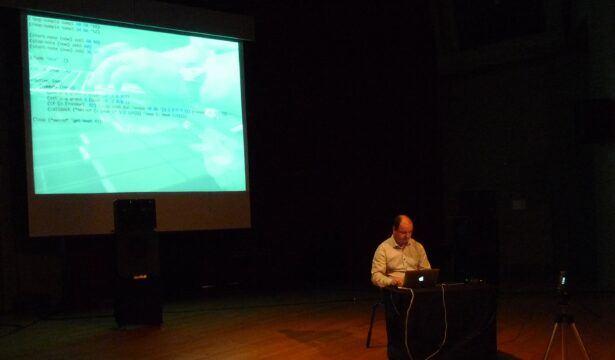Generative Structures is a semi-improvised live coding performance; where computer code is the primary medium of expression but is augmented by live mapping of parameters on a control surface to effect a range of recorded and synthesised sound sources. The title is descriptive of the way coded media structures are written and evolve during the performance in an organic way. As new structures are developed, older ones are modified. The work is particularly concerned with performative mapping and explores the possibilities of timbal creation and deconstruction through the generation of parameter automation and
mapping on the fly.
The work was performed at the Australasian Computer Music Conference, in Wellington, New Zealand, on 8 July 2011, at the University of Auckland. Below is a video of the performance.
Here is a review of the performance by Sarah Keith
“The theme of the 2011 ACMC was ‘Organic Sounds in Live Electroacoustic Music’, which—not surprisingly—saw many compositions themed around sounds of the natural world. Having seen Brown’s live coding performances several times previously as part of aa-cell, I was used to seeing the Impromptu programming environment applied to live-coding rhythmic and tonal works with AudioUnit instruments; so I was curious how (or even if) this performance would fit within the thematic scope of the conference.
The technical set-up for Generative Structures involved (as far as I could discern) a laptop, an iPad, and a nearby camera trained on the performer. The performance started—customarily for live coding performances—with a blank screen, followed by a minute or so of routines being built in silence. Instead of employing conventional instrumental sounds, Brown selected audio samples of wind, rustling, bell-like tones, and subdued bass frequencies. These samples were looped, layered, and re-pitched to form a dense sonic landscape. A string of numbers — 0 2 4 5 7 9 — subtly suggested movements across a major pitch space.
The visual aspect of live coding is crucial, and adds much to the appreciation of the performance. Rather than being an ‘apologist’ move substituting for the lack of instrumental or physical gesture, the projection of the screen and the camera allowed the audience to comprehend the structure of the work. Until this point the visual projection consisted of the Impromptu interface only; now video from the camera stationed on the desk was faintly layered over the top, granting a view of the laptop keyboard and the iPad next to it. The camera trained on Brown’s hands was a reminder of the physical as well as mental dexterity involved in the performance. The iPad was used constantly as a mixing device, adjusting the volumes of the multiple audio streams created; it also appeared to be used to modulate effect parameters and filters.
The constant layering and re-pitching of samples continued; I spied a metro function being used, but the performance was defiantly atmospheric, with few discernible recurring rhythms. New environmental samples of water and birdsong were added, as the code was continually modified. The birdsong provided a touch of humour at this point, blurring the distinction between acoustic sounds and synthetically generated tones. Sinusoidal waves modulated ocean waves, juxtaposing the organic and the inorganic. Continuing the transition into more processed audio material, metallic-sounding samples were then incorporated and densely layered, their granular noisiness contrasting with the pastoral soundscape that had been created previously. The piece concluded with a slowly-building wash of ambient synthesised tones, before fading to silence. In a sense the entire work was organic — building from an atom, recombining and evolving towards a complex structure, before destruction.
Generative Structures provided a pleasing counterpoint to the acousmatic and instrumental performances at ACMC 2011, asserting the ability of the computer itself (or, more accurately, live coding with Impromptu) as a performance medium. It particularly showed the adaptability of live coding to diverse musical forms, when in expert hands. At times it can seem as though the ACMC strays away from creative innovation using the computer, and rests easily on well-worn conventions of digital signal processing for the creation of acousmatic electronic soundscapes. It is refreshing to see a performance which still questions the boundaries of where and how the computer—itself and unashamed—may be used in live musical performance.”

